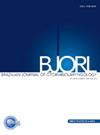Concentrated growth factors promote epithelization in the mastoid obliteration after canal wall down mastoidectomy
IF 1.7
4区 医学
Q2 OTORHINOLARYNGOLOGY
引用次数: 0
Abstract
Objective
This retrospective study aimed at comparing the extent of epithelialization in mastoid obliteration after Canal Wall Down (CWD) mastoidectomy using Hydroxyapatite (HA) alone or using HA in combination with Concentrated Growth Factor (CGF) extracted from autologous blood.
Methods
A total of 56 patients undergoing the CWD mastoidectomy were enrolled. One group was treated by HA, while the other group received HA and CGF for mastoid obliteration (CGF/HA). A review of the medical follow-up records of all patients was conducted, with a primary focus on the otoendoscopic imaging materials. Complete epithelialization was determined by the absence of granulation, discharge, and swelling. The requisite period for complete epithelialization of the mastoid cavity was thus calculated, scored, and analyzed between treatments.
Results
Ear discharge, graft swelling, and poor blood supply were more frequently observed in the HA group. The proportion of patients group that achieved complete epithelialization within 60 days post operation was significantly higher in the CGF/HA group than the HA group. According to the scoring system for complete epithelialization, the median score of the CGF/HA group was 2, significantly higher than that of the HA treatment group (median score = 1, p = 0.032). Altogether, our results indicated that duration needed for complete epithelialization in the CGF/HA group was shorter than the control group.
Conclusion
The application of CGF to surgical cavity obliteration following a CWD mastoidectomy significantly promotes epithelialization, thereby achieving satisfactory results. Randomized controlled trials with a larger number of patients enrolled were worth launching in the future to better substantiate the value of CGF in obliteration of mastoid cavity.
Level of evidence
Level 2-Oxford Centre for Evidence-Based Medicine 2011 Levels of Evidence.
求助全文
约1分钟内获得全文
求助全文
来源期刊

Brazilian Journal of Otorhinolaryngology
OTORHINOLARYNGOLOGY-
CiteScore
3.00
自引率
0.00%
发文量
205
审稿时长
4-8 weeks
期刊介绍:
Brazilian Journal of Otorhinolaryngology publishes original contributions in otolaryngology and the associated areas (cranio-maxillo-facial surgery and phoniatrics). The aim of this journal is the national and international divulgation of the scientific production interesting to the otolaryngology, as well as the discussion, in editorials, of subjects of scientific, academic and professional relevance.
The Brazilian Journal of Otorhinolaryngology is born from the Revista Brasileira de Otorrinolaringologia, of which it is the English version, created and indexed by MEDLINE in 2005. It is the official scientific publication of the Brazilian Association of Otolaryngology and Cervicofacial Surgery. Its abbreviated title is Braz J Otorhinolaryngol., which should be used in bibliographies, footnotes and bibliographical references and strips.
 求助内容:
求助内容: 应助结果提醒方式:
应助结果提醒方式:


